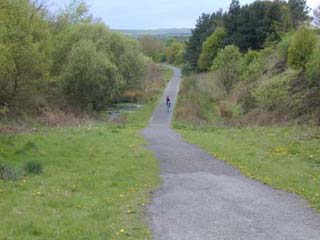
AMPHIBIAN AND REPTILE SPECIES IN THE UK
The UK herpetofauna is not rich in number of species. There are twelve, possibly thirteen native species.
AMPHIBIANS

Amphibian habitat in northeast England. Ponds and ditches at this site support common frogs, common toads, smooth newts and palmate newts.
Amphibians are small creatures with a water-permeable skin, which restricts them to damp habitats, although some are more tolerant of dryness than others. All species in the UK require water for breeding, and lay waterborne eggs. These develop into tadpoles which eventually change into the adult form, and leave the water. This metamorphosis is characteristic of amphibians.
Breeding takes place in spring, although common frogs may breed as early as January in some areas. After breeding has finished, the adults usually leave the water, and do not return until the next year.
Being ectothermic ('cold-blooded'), amphibians cannot generate their own warmth. They are thus not active at low temperatures, and will retreat into frost-free hiding places in the winter, where they remain in a state of torpor until the weather becomes warmer. Some may spend the winter in the water they will breed in come spring.
Native amphibians in mainland Britain are represented by three species belonging to the order Urodela (newts and salamanders), and three (possibly four) belonging to the order Anura (frogs and toads). In addition, there are a number of additional species which occur only on the Channel Islands. There are also introduced species which have lived and bred in the wild for varying periods of time.
REPTILES

Reptile habitat in northeast England. This site supports adders, common lizards and slowworms.
Unlike amphibians, reptiles have dry, scaly skins, and have no need for water for breeding. Reptiles may have live young, or lay eggs, and the offspring produced are generally miniatures of the adults, and undergo no metamorphosis.
Unlike amphibians, reptiles have dry, scaly skins, and have no need for water for breeding. Reptiles may have live young, or lay eggs, and the offspring produced are generally miniatures of the adults, and undergo no metamorphosis.
Like amphibians, reptiles are ectothermic, and rely on external heat sources to maintain their body temperature. They prefer somewhat higher temperatures than amphibians, and will often bask in the sun, or lie on objects warmed by the sun, to raise their temperature to that necessary for activity.
Native reptiles in mainland Britain are represented by three species belonging to the suborder Sauria (lizards), and three belonging to the suborder Serpentes (snakes). As with the amphibians, a couple of additional species occur only on the Channel Islands. A number of species have been introduced in the past, although these have not remained for as long as with the amphibian species.
Snakes (Natrix,
Vipera, Coronella)
OTHER SPECIES
There are, as mentioned above, a number of species that occur on the Channel Islands, but not on mainland Britain. There are also species from other parts of the world that have been released in this country, some of which have become established.
IDENTIFICATION
Identification of reptiles and amphibians in the UK is relatively easy, due to the small number of species.
Identifying Amphibians and Reptiles in the UK
REFERENCES
A number of publications, as well as personal experience, were used in the compilation of these pages. Those relating specifically to certain pages are listed on those pages. More general references are listed below.
Beebee, T., & Griffiths, R., 2000. Amphibians and Reptiles- A Natural History of the British Herpetofauna. New Naturalist/ Harper Collins, London.
Frazer, D., 1983. Reptiles and amphibians in Britain. New Naturalist/ Collins, London.
Slater, F., 199?. The Common Toad. Shire Natural History, Aylesbury.
Stafford, P., 1987. The Adder. Shire Natural History, Aylesbury.
Stafford, P., 1989. Lizards of the British Isles. Shire Natural History, Aylesbury.
Wisniewski, P. J., 1989. Newts of the British Isles. Shire Natural History, Aylesbury.
Ellis, E. A., 1979. British Amphibians and Reptiles. Jarrold, Norwich.